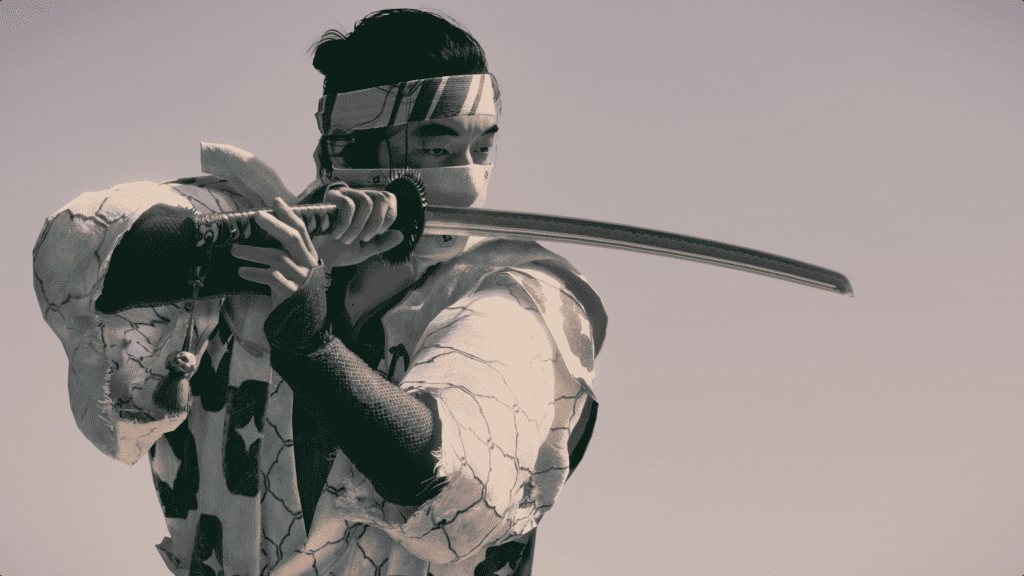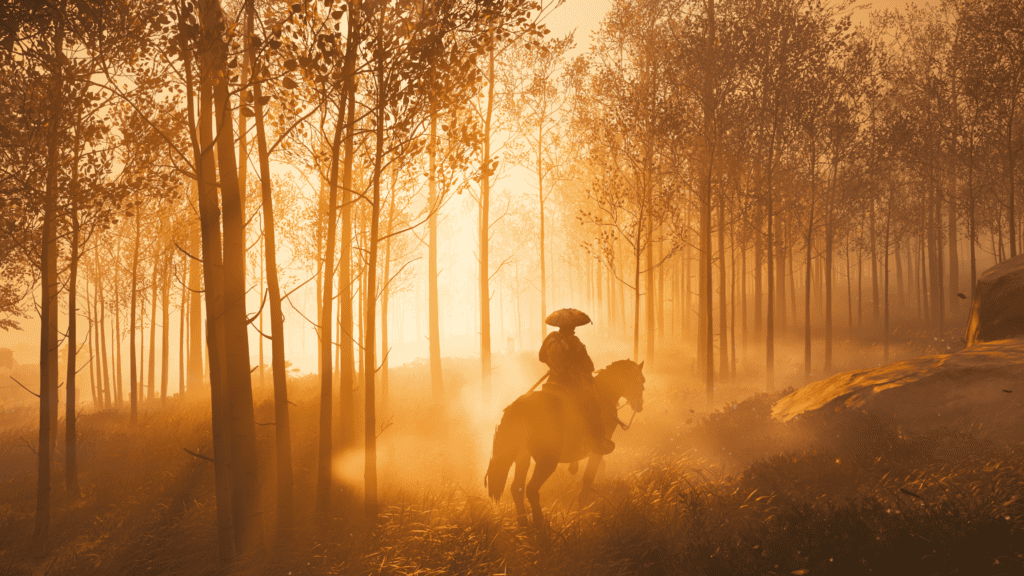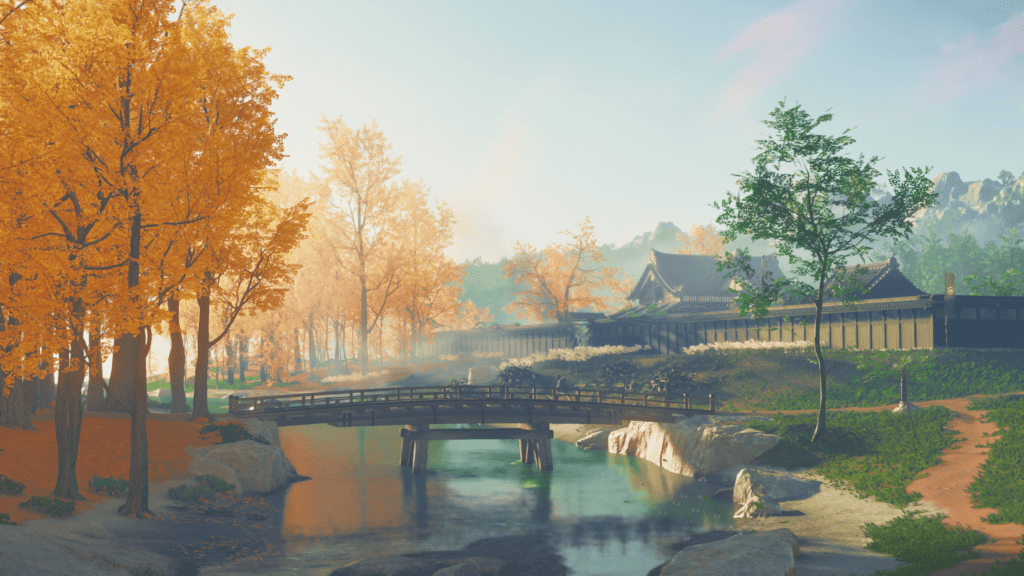Independent of mainland Honshu, the diminutive Japanese island of Tsushima stands alone as the penultimate point of conquest for the invading Mongol army. For the forces of Khotun Khan, an ambitious nephew of Genghis, Tsushima is ideally placed to serve as the staging ground for a full-frontal invasion of the entire country. Their attack upon the island is decisive, and their successful dominion over its populace even more so—whoever resists subjugation is promptly put to the sword, and that includes the island’s sworn protectors within the samurai order. It’s a whirlwind start to the game that culminates with you stepping into the shoes of protagonist Jin Sakai, one of the few native samurai to survive the initial assault. With the fires of warfare soon at your back, then begins the process of liberating the island little by little. Though its tumultuous opening is awash with blood and gore and glory, this latest endeavour from Sucker Punch Productions operates at a far more reserved pace thereafter. Jin’s journey is foremost a meticulous examination of his homeland and the ruination that has been brought upon it. In spite of the war that has engulfed the island, Ghost of Tsushima meets its widespread destruction with prevailing beauty, and frequently spurns the chance to devolve its story into the basest of open-world fodder.
Confidently subdued, the open-world that Sucker Punch have created is a remarkable success of refinement. Rather than blindly defying the tropes of the modern open-world game, Ghost of Tsushima instead delivers a scaled-back experience without needing to making any noticeable concessions. That means relevant staples of the genre, such as character progression and player freedom, remain unhindered even as the core gameplay loop is ridden of as much excess as possible. Much of this is evident in the size of the game’s environment. Tsushima island certainly isn’t the largest map of its kind, but it maintains its sense of scale without needing to rely on an abundance of scattershot map markers filling in every blank patch of land, or the inclusion of an arduous fast-travel system. Similarly, the generous number activities available, while being unambitious in scope, never feel as though they’ve been imagined as an afterthought. Everything that you can see and do in Tsushima is an inseparable part of a persistent world, one that has been built in reverence to a culture never before experienced from this perspective. And just as impressive is the way in which major side-quests are threaded together, supplementing one-note missions rather than being lost among them. As Jin’s journey slowly pushes him towards the northern reaches of the island, so do the game’s accompanying side-quests follow him in tow. You’re never a world apart from the next thing you need to do, and given the uniformity of every narratively driven excursion, things remain completely manageable even as the land of Tsushima continues to grow around you.
With Jin Sakai rarely departing from the learned stoicism of the samurai, it’s the supporting cast that give the story of Ghost of Tsushima much of its colour. The self-contained narratives within the game’s marquee side-quests introduce us to Jin’s allies in a much more intimate fashion, and like the majority of the story-driven distractions in the game, the atrocities of war are at the forefront of each of them. Divided into nine chapters, the Tales of Tsushima progress at a similar pace to the main narrative and conclude right around the time that the game enters its final act. Showcasing the invasion from a perspective outside of the samurai order, rarely do these missions shirk from portraying the depravity of wartime strife, even shining the light on adversaries that are a little closer to home. While I was often left frustrated by how the nine-mission formula stretched encounters a little too far on occasion, the progression of the characters within them remains consistent and believable. Much of that is due to how these supporting characters serve as the ideal counterweights to Jin and his emotional passivity. Although Jin remains the exception, it’s a stark contrast to see his allies portrayed with such vulnerability even as he seems evidently unshakeable. By humanising Jin’s fellow warriors and highlighting their own unique struggles, the breadth of the war, from its colossal clashes of steel to its inter-political treachery, broadens immensely. Every Tale of Tsushima is a window into an entirely different viewpoint of the invasion. Most importantly, the stories that you become a part of succeed in strengthening your connection with the world by laying bare the human and cultural cost of the war. No matter how each of these stories pans out, everything gradually filters towards the prevailing threat, creating a satisfying wholeness across the entirety of the game’s narratively driven content.
THE INCLUSION OF A PHOTO-MODE IS A BOON. TSUSHIMA’S IS ONE OF THE BEST YET, OFFERING EVERYTHING FROM PARTICLE EFFECTS TO CLOUD CYCLING
While the devastation of war has left plenty of blemishes upon the land, the island of Tsushima remains a picturesque paradise of idyllic natural beauty and inspiring aesthetic design. Eking out every last iota of power that the PlayStation 4 has to offer, Sucker Punch have created an environment that is just as visually appealing as it is technically impressive. Steeped in authenticity, the rich diversity of biomes and captivating sound direction each elevate one another to create an atmosphere that feels completely detached from the turmoil of war. The guttural bellows and scything of flesh are plenty convincing once you engage in battles, but much more integral to the natural melody of Tsushima is the way in which the environment is so uniquely multifaceted. Like the shadow in your wake, it will breathe during moments of calm and thrash wildly as blood begins to spill. It’s immersive without being distracting, and much of that can be attributed to the way in which the game’s design pivots away from the more fantastical elements of the samurai mythos whenever possible. The Ghost’s abilities are very much grounded in reality, though there are plenty of subtler ways in which he is able to harness the power of the divines while remaining decidedly human.
Central to your journey is the guiding wind, a contextual stream of air that pushes you in the direction of your next meaningful encounter. As well as helping to reduce the clutter of visual information that the open-world genre is often inseparable from, the guiding wind also serves as the tenor for the symphony of sound that dresses every field and thicket in an enchanting verve. With a single stroke of air, the audible swaying of pampas grass and the crackling of bamboo shoots tells you all you need to know about your immediate surroundings. Should you lose your bearings, a simple swipe of the touchpad will summon another gust of wind at your back, and in a flurry of sound and motion, canopies, birdsong and distant voices will kick up into the breeze once more. With no mini-map to refer to or breadcrumb trail to follow, you quickly become more reliant on the guidance of your surroundings. Save for allocating my skill points, it was rare for me to spend more than a moment at a time admiring the designs of the pause menu. By utilising the guiding wind as an important part of the game’s visual language, Tsushima is able to maintain an impressive tonal consistency. Most noticeably, the guiding wind greatly cuts down on the gamification of movement by keeping the player rooted in the game-world. Spending so little time plotting a course through the menu means that you become more reliant on multi-sensory pathing to guide you in the right direction. Whether it’s the beckoning of golden songbirds or the distant warbling of a Mongol war chant, you’re never left entirely dependant on compass points to maintain your sense of direction. And neither are you left to regularly plot and replot courses in order to explore the breadth of the game’s content.
EVERYTHING IN TSUSHIMA FILTERS BACK TO THE WAR. NO MATTER THE SIZE OF THE QUEST, YOU’LL ALWAYS BE FIGHTING FOR THE ISLAND’S LIBERATION
Between the remarkable design of Tsushima’s colourful biophony and the emphasis on keeping the player in-world as much as possible, immersion within the game is easily achieved and rarely broken. With sword in hand, the otherwise placid and contented tone of the game is washed away by flourishes of violence, with swordplay as lethal as it is satisfying. Combat in Ghost of Tsushima relies upon stances, with there being four interchangeable styles for you to choose from that you can switch between on the fly. There’s a unique stance for all four major enemy archetypes, and as you begin to identify these specific enemies in the heat of battle, rapidly chaining together different styles becomes one of the most integral gameplay rhythms. What frequently undermines this though is an awkwardly formed control scheme that tries to do too much with too few inputs. Like most elements of Jin’s offensive repertoire, stances can be improved though unlocking skills. Once you find yourself boasting a full suite of deft manoeuvres, deadly gadgets and distraction tools, your unmatched versatility allows you to dictate combat encounters with a growing influence. What often breaks the zen-like flow of stance-switching and sword slashing are the regular fumbles that occur when reaching for your next offensive tool. Far too regularly I would mistakenly draw my bow when looking for a bomb, or pull out a non-lethal wind chime from a pocket where I had expected to find a kunai knife. With everything relevant to a battle being confined to the two triggers, larger-scale fights often devolved into messy scraps that became harder to manipulate the more errors that I made. Even outside of combat, condensing too many actions onto a single button led to plenty of issues. Not just content with the right trigger being used to pick up items, it was also the go-to command required in order to talk to civilians, analyse tracks, mount your horse and to quick-fire smaller weapons from the hip.
Stylistically, combat in Ghost of Tsushima is brought to life through spectacular choreography and a marked appreciation for motion. While the moves that Jin is capable of may look challenging, timing and reactions play a much more important role than raw skill or a deep understanding of enemy move-sets. Never are you made to gauge your character’s level of exertion, and there’s no hidden trick to winning fights. Whether it’s a duel or an open-ended brawl, the rules of engagement remain simple and straightforward—you can defend yourself by blocking, turn defence into offence with a well-timed parry, or evade contact altogether by deftly sidestepping any strike. As important as timing is when it comes to imposing yourself in a fight, you’re rarely punished for missing a single window of opportunity, which is something of a relief given that you’re regularly faced with a dozen or more opponents at a time. The combat experience in Ghost of Tsushima is at the very opposite end of the spectrum to Soulsborne titles, designed so as to be easily understood rather than as a blockade to be surmounted. In fact, it likely won’t be too long after the opening title crawl that you emerge from your first fight completely unscathed. Thereafter, it’s much easier to become the aggressor of every conflict, actively pursuing roaming war parties and running head-on into enemy encampments in search of a challenge. Enemies do become slightly tougher as you progress through the game, most notably in the number of different ways that they adapt to meet the rising threat of the Ghost. Though there’s never any fear that things will become too overwhelming, as character progression and enemy scaling remain comfortably in parallel with one another. There’s balance in the simplicity of combat, and there’s plenty of fun to be had in its broad accessibility. Most impressively, mastery of the samurai arts is outwardly achievable no matter your skill level, with player empowerment adeptly reflected in the ease and elegance of swordplay.
Ghost of Tsushima isn’t likely to be the game that converts those already averse to the open-world experience. At least structurally, there’s a lot here that feels familiar. Rather than tackling the underlying rhythm present in many open-world adventures, Sucker Punch have instead pivoted their focus towards making the best of what is already to be expected from the genre. This isn’t so much a reinvention of the norm as it is a reinvigoration. Altering only the most necessary components, Ghost of Tsushima sheds the rust accumulated by its predecessors and stands out for all the right reasons. With no reliance on excessive course plotting, no dependance on hollow filler content and a meaningful world that values the time you spend within it, Sucker Punch’s approach to refinement is a marked success. And as a final word on the eighth generation of consoles, Ghost of Tsushima ensures that the era of the PlayStation 4 finishes with a flourish.


